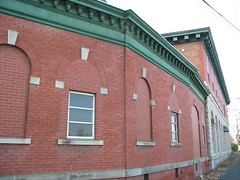The 4 R's of Historic Preservation and Community Revitalization: Restoration; Rehabilitation; Redesign; Relocation
Because of family ties, local preservation activist Peter Sefton (Victorian Secrets) is also involved in preservation advocacy in upstate New York, including helping beleaguered activists in Troy, NY, a city that like most of the cities upstate, has been left behind by the increased globalization and de-industrialization of the U.S. economy.
From Peter:
 Curved rear wall of the Freihofer Bakery in Troy, New York.
Curved rear wall of the Freihofer Bakery in Troy, New York.Troy, New York’s 1913 Freihofer Bakery and 1895 Riverside Club have apparently won another week of life. The buildings could have been demolished today under the terms of a demolition permit applied for by the building’s owner. However Justice James Canfield has granted preservationists a one-week stay pending a court appearance next Thursday. The buildings, however, remain in grave danger of demolition.
Click here for pictures of the historic bakery and clubhouse; the text refers to a prior demolition effort to demolish the buildings for a drugstore, which the Historic Action Network successfully opposed.
For more, check out "Time is running out for two historic buildings near the Waterford Bridge in Lansingburgh" from the Troy Record.
__________________
In the article, "Geneva History Center explores ways of historic preservation," from the Geneva Courier News in Illinois, Jan Ramming writes:
"Picture an old church converted to a resale shop, a bank turned into a fine restaurant, and an abandoned factory being used as an upscale hotel. It has happened in Geneva through the creative use and preservation of historic buildings. Finding new uses for old buildings is one way communities can save their historic landmarks, according to Michael Dixon, a local architect. He was the speaker at the Geneva History Center's Brown Bag Lunch meeting Tuesday.
"You have to find new use for the building to keep it in the mainstream of contemporary life," he said. "You may need to make some adjustments, and with sensitivity."
But the city has lost its share of history as well, and that's the focus of the Historic Center's new exhibit "To Be or Not To Be?" The exhibit opened this May in honor of National Historic Preservation Month.
The exhibit asks visitors whether it is ever acceptable to demolish historical buildings, and shows photos and models of the detailed old architecture of the Swedish Lutheran Church and the 1892 Train Depot, both demolished.
The exhibit shows that historic preservation may involve different processes. They are:
• Restoration — Accurately returning the building to its original state.
• Rehabilitation — Maintains the original state outside but updates the inside.
• Redesign — Done when not all of the old structure can be reused.
• Relocation — Saves and moves structures that sit on land desired for other uses.
Photos are shown of residential teardowns and infills — the practice of razing modest houses and replacing them with lot engulfing structures, called infill houses.
______________
An interesting way to think about what we do in thinking about historic preservation as the foundation for community revitalization and how we go about it.
One caveat, I will say that location matters. Geneva, west of Chicago, is in a strong and thriving metropolitan area. Troy, NY is not...



0 Comments:
Post a Comment
<< Home